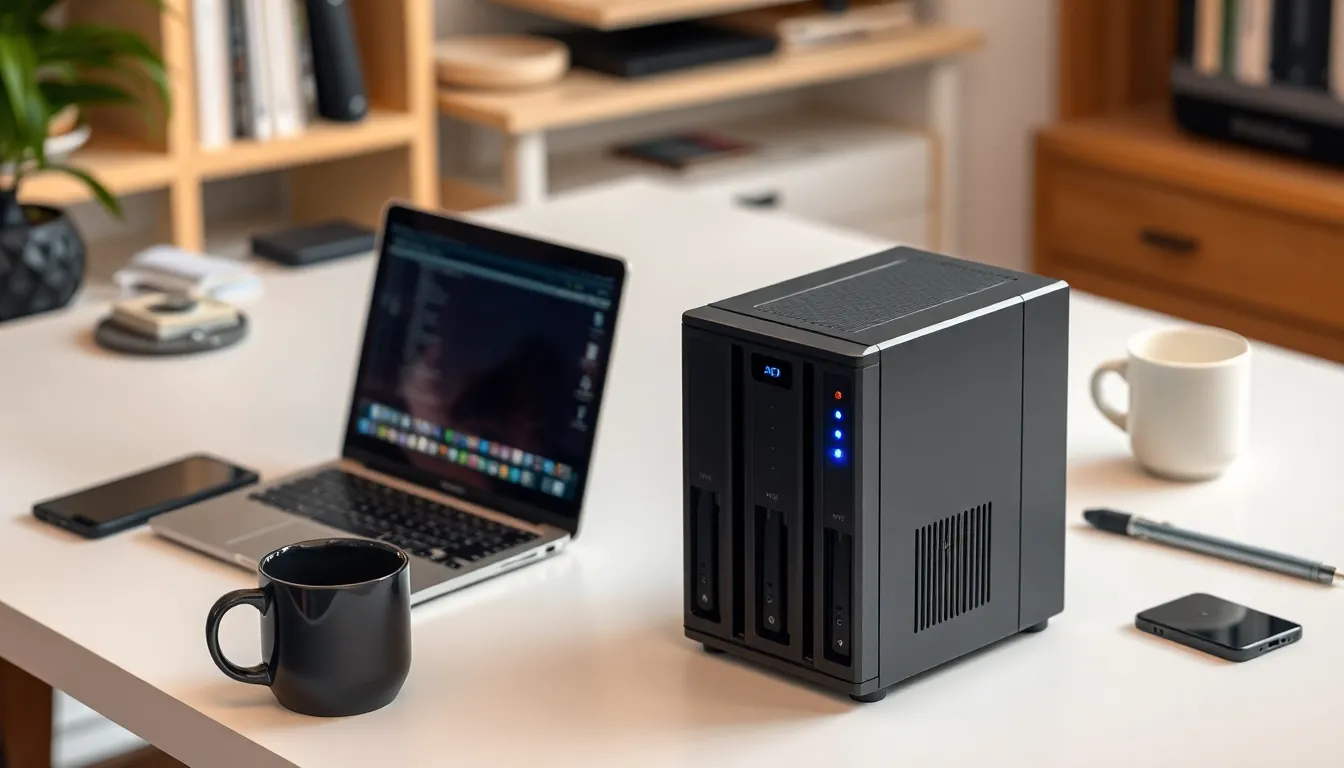Table of Contents
ToggleSetting up a NAS device might sound like a task only a tech wizard could tackle, but fear not—it’s easier than finding the remote control in a couch full of snacks. Imagine having all your files in one place, accessible from anywhere, and secured like a secret vault. It’s like giving your data a cozy home where it can thrive.
What Is a NAS Device?
A NAS device serves as a dedicated file storage system connected to a network. Users access data on the NAS through multiple devices, including computers, tablets, and smartphones. Functioning as a centralized hub, it offers convenient file sharing and collaboration among users.
Designed for easy setup, NAS devices require minimal technical skills. Many models include user-friendly interfaces, simplifying the initial configuration process. Storage capacities vary, often ranging from a few terabytes to several petabytes. Scalability allows users to expand their storage space as needed.
Security features play a crucial role in protecting data. Most NAS devices support encryption, secure access controls, and regular software updates. These measures ensure that sensitive information remains safe from unauthorized access.
Accessibility defines the user experience with NAS devices. Data remains accessible from anywhere with an internet connection, effective for remote work and personal use. Applications often enable streaming multimedia content directly from the NAS, enhancing entertainment options.
Performance considerations include data transfer speeds and the number of simultaneous users. High-performance NAS systems utilize faster hard drives or SSDs to improve load times and responsiveness. Some devices offer RAID configurations to increase redundancy and data protection.
Businesses benefit significantly from implementing NAS devices. Centralizing data storage improves organization and enhances collaboration among team members. Companies can also manage backups and archives efficiently, minimizing risks of data loss.
Benefits of NAS Device Setup

NAS devices offer several advantages, especially regarding data management and accessibility. They streamline file storage and provide various functionalities for multiple users.
Data Storage and Backup
Centralized data storage simplifies file management for individuals and businesses. Users can back up important data conveniently, ensuring updates occur regularly. Most NAS devices support automated backup solutions, reducing the risk of data loss. Scalability becomes essential as data needs increase; many devices accommodate additional drives for expanded storage. Access speed also plays a significant role, as high-performance units provide quicker data retrieval. Furthermore, built-in redundancy features like RAID configurations enhance data protection, ensuring critical files remain intact even during hardware failures.
Media Streaming
Entertainment options expand significantly with NAS devices. Many models support multimedia streaming, allowing users to access videos, music, and photos seamlessly. High-resolution content can stream smoothly across various devices, enhancing the viewing experience. Compatibility with popular applications ensures easy media organization and playback. Some NAS devices even integrate with smart TVs and streaming services, creating a home entertainment hub. Users can enjoy their media library without relying on third-party services, enhancing privacy and storage control. Streaming capabilities also facilitate sharing files with friends and family, promoting social engagement around shared media experiences.
Steps for NAS Device Setup
Setting up a NAS device involves several key steps. Proper execution ensures optimal performance and user satisfaction.
Choosing the Right NAS Device
Selecting the appropriate NAS device requires careful consideration of specific needs. Assess storage capacity, as options can range from a few terabytes to multiple petabytes. Evaluate additional features such as multimedia streaming capabilities and RAID support for data protection. Compatibility with existing devices matters; ensure the NAS supports the operating systems in use. Finally, factor in price and brand reputation, which can significantly influence long-term satisfaction.
Connecting Your NAS Device to the Network
Connecting a NAS device to a network involves straightforward steps. Begin by using an Ethernet cable to connect the NAS directly to the router for stability. Power up the device, and confirm that the network connection is established. Verify connectivity by checking the device’s IP address, often displayed through its LED indicators. Utilize NAS manufacturer applications for automated network detection and setup, simplifying the process for users.
Configuring the NAS Device Settings
Configuring the settings on a NAS device establishes its functionality and security. Access the device’s user interface through a web browser using its IP address. Set up user accounts and permissions to control access based on individual needs. Configure storage options, including RAID settings, to enhance data protection. Update the firmware to ensure the latest security features and fixes. Finally, enable remote access, allowing data to be accessed securely from any location.
Troubleshooting Common Setup Issues
Setup problems may occur during NAS device installation. Users often encounter connectivity issues, where devices fail to connect to the network. Ensure the Ethernet cable is firmly connected to both the NAS device and the router. Verifying the router’s settings can also reveal potential bandwidth restrictions.
Another frequent issue involves configuration errors. Users might overlook assigning an IP address to the NAS. Access the device manual for specific instructions on how to configure network settings. It’s essential to check that the firmware is up to date to ensure optimal performance.
Access denial may arise when users attempt to connect remotely. Confirm that remote access settings are correctly configured within the NAS interface. Firewalls or security settings on routers can also block connections, so adjusting these settings may resolve the issue.
Slow performance can frustrate users during file access. This issue might stem from insufficient storage space. Monitoring the available storage capacity can prevent this issue. Users should consider upgrading or adding drives to improve data retrieval speeds.
Data loss is a critical concern for NAS users. Regular backups are vital to maintaining data integrity. Implement automated backup solutions that the NAS device offers to minimize risks. Utilizing RAID configurations can also enhance data protection through redundancy.
Lastly, streaming issues can affect multimedia functionality. Confirm that the NAS is compatible with streaming services. Users should verify the settings for multimedia streaming to ensure proper access across devices. Checking network compatibility may also help enhance streaming experiences.
Setting up a NAS device opens a world of convenience and security for data management. With user-friendly interfaces and straightforward processes anyone can create a centralized hub for their files. The benefits extend beyond just storage; enhanced accessibility and multimedia streaming capabilities transform how users interact with their data.
As they navigate the setup process they should remember the importance of security settings and regular updates. Troubleshooting common issues can ensure a smooth experience and maximize the device’s potential. Embracing a NAS device not only simplifies file sharing but also enriches personal and professional digital environments.





